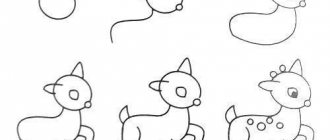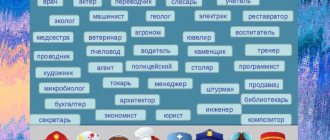Preview:
Self-analysis of an open lesson with non-traditional
drawing techniques “Autumn trees”
Direct educational activities were carried out with children of senior preschool age with a subgroup of 10 children.
GCD theme: “Autumn trees.”
Type of educational activity: continuous educational activities are integrated, because through various contents and activities, the main goal of the event is achieved.
Dominant educational field: artistic and aesthetic development.
The purpose of GCD: to develop children's interest in artistic creativity through the use of non-traditional drawing techniques.
- Educational – introduce children to a new type of drawing prints with leaves, teach them to place the image over the entire surface of the sheet, choose the necessary technique and color solutions.
- Developmental – to develop aesthetic perception.
- Educational – to cultivate accuracy when working.
Objectives of integrated educational areas:
- "Speech development". Develop dialogical speech.
- "Cognitive Development". Cultivate interest in your own discoveries through search activities.
- "Physical development". Help relieve physical and mental stress with exercise.
Preliminary work: conversations, stories, observation, looking at illustrations.
The lesson consists of three parts:
- Organizing time.
- Main part.
- The final part is the conclusion of the lesson.
The duration of the lesson is 25-30 minutes, which complies with SanPin standards.
GCD corresponded to the interests of the children, the temperament and level of preparedness of the pupils.
The organization of children's activities corresponded to teaching, developmental and educational tasks. The logical presentation of the material, accessibility, as well as the creation of a game situation contributed to the formation of children’s knowledge throughout this continuous educational activity. The transition from one type of activity to another made it possible to involve each child in an active process.
Various methods were used in GCD: verbal throughout all educational activities; visual – display of illustrative material; game - a surprise moment; practical; control and stimulation in the form of approval and praise; artistic word.
The main part of the ECD included independent, mental and practical activities of children aimed at completing all assigned tasks.
The main part of the ECD included tasks for the perception of new knowledge, systematization of children’s existing knowledge in independent activities.
In order to relieve static tension, as well as increase mental performance and reduce fatigue, physical exercise was performed.
Individualization of learning was manifested in helping children who had difficulty completing tasks, repetitions, reminders, and additional explanations.
During practical work, the children showed increased interest in the task and the children were interested; no fatigue was observed. During verbal communication while the pupils were doing work, she gave a positive assessment of the children’s activities.
The final part of the GCD summed up the activity using the method of analyzing the success of the task.
Conclusion: all the tasks set during the planning of the GCD were solved, the goal was achieved. Each child produced a beautiful autumn picture. Educational activities contributed to increasing playful motivation for learning, creative development, and cognitive interest. The level of activity of the children was at a sufficient level. All children were involved in the activity, interest was maintained throughout the entire educational activity.
Source
Self-analysis of ECD for drawing in the senior group “Forget-me-not Gzhel”
Anna Efremova
Self-analysis of ECD for drawing in the senior group “Forget-me-not Gzhel”
Efremova Anna Borisovna
Self-analysis of GCD in the senior group (Drawing - Forget-me-not Gzhel)
Direct educational activities were carried out with students in the sixth year of life from a general developmental group of 18 people.
NOD "Forget-me-not Gzhel"
Goal: Continue to develop knowledge about Gzhel painting. Exercise children in creating Gzhel patterns and compositions.
Objectives: Practice creating Gzhel patterns and compositions. Exercise children in gouache painting. Continue to learn how to use several brushes of different thicknesses in painting. Development of drawing skills with the tip of the brush and the entire bristle. Strengthen dipping skills.
Educational areas: “Artistic and aesthetic development”, “Cognitive development”, “Speech development”, “Social and communicative development”.
Glossary: going well (work, tureen, decoration.
Preliminary work: Conversations: “Gzhel”, “Fairytale Gzhel and its origin”, “Gzhel masters”; Consideration of the album “Gzhel Painting” (examination of painting elements and compositions, GSD “Introduction to Gzhel Painting”, GZhel Patterns GCD, GZEL “Spreading Tree” GCD (on the subject of Gzhel painting, individual work on developing painting elements; glossary: products, craftsmen, candlestick, pattern, etc.; D. and.: “Fold the pattern”, “Choose a sweet word”, learning the poem “Gzhel”, getting acquainted and learning with physical education - minutes “Hello brothers”.
Methods and techniques:
Verbal:
Literary word explanation, clarification, advice, teacher's story, physical education - just a minute.
Visual:
exhibition of Gzhel products, decoration of the group.
Gaming:
game moment “Magic words” (transformation into masters).
Practical:
progress of work, drawing elements of a pattern in the air, physical education - a minute, listening to a song, musical accompaniment of work.
Materials and equipment: Oilcloth, gouache (white and blue, brush stand, 2 brushes, thin and thicker (No. 3, No. 5), water jar, palettes, paper napkins, various cut-out utensils or other items for decoration (vase, tureen, jug, plate, towel, handkerchief, etc., Gzhel products for the exhibition, tape recorder, recording of the song (Forget-me-not Gzhel" - Author: Yuri Mikhailovich Chichkov, performer: Nadezhda Filatova)
Duration 25-30 minutes (including viewing the exhibition).
The conditions for carrying out the GCD met SanPin standards: a clean room, fresh air, good lighting, furniture appropriate for the height of the children, and safety rules were followed. Preliminary work has been carried out.
The content of the tasks is structured taking into account the principle of integration of educational areas: artistic-aesthetic, cognitive, speech, social-communicative and physical development within the framework of the implementation of the Federal State Educational Standard. To implement the assigned tasks, all groups of methods and techniques were used: visual, verbal, practical, game.
The lesson was a success. In advance, the group was decorated with balloons (blue, white and light blue) with bouquets of forget-me-nots. An exhibition of Gzhel products was prepared. The lesson began with artistic expression. During the introductory part, there was a game moment “Becoming masters”, which allows you to attract the attention of children and interest them in the work.
The lesson was not drawn out, there was a physical education lesson - finger gymnastics. The stages of the lesson were sequential, with a logical transition from one to another.
Musical accompaniment contributed to the creation of a relaxed creative atmosphere and a positive emotional mood.
In the process of children’s independent work, an individual approach was carried out, which manifested itself in providing assistance to those who had difficulty completing a task, in the form of a reminder, additional explanation, joint drawing (hand in hand, taking into account the peculiarities of thinking and the pace of perception of each child.
Praise, encouragement, emphasizing achievements also stimulated and maintained the interest of children throughout their educational activities. The outcome of the activity was carried out using the method of analysis and assumed a positive individually differentiated assessment of the children’s activities and self-assessment of the results of the activities by the pupils. The children independently exhibited their works at the exhibition, and then expressed their opinions about the works.
No difficulties were identified during the direct educational activities. All children were active participants throughout the entire activity, showing increased interest from its first stages, while experiencing emotional and aesthetic pleasure. The children's works turned out to be interesting, expressive, unique and delighted the preschoolers.
I believe that the goal of direct educational activities has been achieved, the assigned tasks have been solved.
Preview:
Self-analysis of GCD for drawing using non-traditional techniques “Winter Landscape”
Topic: “Winter landscape”
The lesson was conducted with children from the preparatory group; there were (7) children present. Children easily make contact with adults. They know how to hear and listen to the teacher.
When developing this lesson summary, I first of all took into account the age and mental individual characteristics of the children in the preparatory group.
Taking all this into account, I outlined the goal, objectives, content of the lesson, determined the form of delivery, methods, techniques and means necessary for positive results.
Purpose of the lesson: to evoke aesthetic feelings towards nature and its images using an unconventional drawing technique.
During the lesson it was expected to solve the following problems
- To clarify children’s ideas about landscape as a genre of painting;
- Develop the ability to correctly ask a question that requires a clear answer;
- Develop creative abilities in the process of one’s own artistic activity through the use of non-traditional materials and drawing methods;
- To promote the development of the ability to analyze and express one’s opinion;
- Develop cognitive processes; Mental operations: analysis, comparison, generalization;
- Cultivate interest in understanding nature, displaying ideas in visual arts.
In accordance with the requirements of the Federal State Educational Standard, she used the following types of activities: gaming, cognitive, productive, motor.
Methods and techniques:
-methods of consciousness formation (individual and frontal conversation);
-methods of organizing activities and developing behavioral experience (games, speech situations);
-methods of stimulating behavior (encouragement);
-methods of control, self-control and self-assessment (survey, analysis of the results of one’s own activities);
-methods of organizing and implementing cognitive activity (story, modeling a picture);
-methods of saving, preserving and strengthening health (games “Bring the Picture to Life”, finger play “Snowball”)
To successfully solve the identified problems, I have prepared the following:
Preparatory work: conversation about winter; viewing and talking about landscape paintings; drawing “Autumn landscape”; the use of modeling in direct educational activities.
Equipment and materials: models, tinted sheets of cardboard (for each child), stacks, skewers, ready-made dough for drawing; rags, Velcro pictures depicting objects and natural phenomena, plastic cups, audio recording of P.I. Tchaikovsky “Seasons. February” exhibition of paintings, presentation of paintings by famous artists.
The end result for the child: knows how to depict a winter landscape using an unconventional drawing technique, plans his activities and implements a preliminary plan, freely navigates a limited surface.
I think that drawing with non-traditional techniques aroused interest and activity among children.
The lesson consisted of three parts.
Contributed to the creation of psychological comfort. We set the children up for active work, positive contact with each other, provided psycho-emotional release, and created interest in the upcoming activity.
2. Main part.
Aimed at creating a positive emotional mood and developing the educational situation itself. This part of the educational activity used a combination of game motivation, visual, verbal and practical methods.
1. To describe natural phenomena in winter, I used the didactic exercise “Winter - good, bad...”, as a result of which the children’s vocabulary is enriched with adjectives characterizing natural phenomena.
2. I solved the problem of developing visual perception, memory and logical thinking and cognitive activity in the process of viewing landscape paintings and working with model pictures related to the landscape.
3. Emotional expressiveness and the ability to convey the mood of a picture were reflected in the theatrical sketch-improvisation “A Picture Alive”. The children's ability to correlate words with movements and the expressiveness of performing movements was strengthened.
Determining the purpose of the topic (drawing a landscape)
Physical education was carried out. In order to develop fine motor skills of the fingers.
Independent productive activity.
3. Final part.
Assessment of children's performance and self-esteem. Summing up the results of the GCD.
All stages of the lesson were interconnected and interdependent, subordinated to the given topic and goals of the lesson. Changing the type of activity at each stage of the lesson helped prevent fatigue.
I don’t forget that play is the leading activity for preschool children, so I offered the children the games “Winter – good, bad...”, “Picture Alive”.
During the lesson, to ensure the efficiency of the children's team, I used the following forms of organizing children's activities:
Team work with model pictures.
— Individual. Each child drew independently.
Throughout the entire lesson, I paid attention to the children’s speech: I sought complete answers, posed searching questions about how we could draw, and created conditions for dialogue with the children.
During the lesson, the children were active - they participated in the game and answered questions.
The children's interest remained throughout the lesson. The children were attentive.
Summing up the lesson, I involved the children in this and asked them to speak on the topic of what we know about painting and what other ways can we draw pictures.
CONCLUSIONS: – The stated topic was fully consistent with the content of the lesson.
— I believe that I managed to fully implement the assigned tasks.
Source
Self-analysis of the integrated lesson
MUNICIPAL BUDGETARY PRESCHOOL EDUCATIONAL INSTITUTION
“KINDERGARTEN “SWALLOW” A. KYZYL – OCTOBER”
Self-analysis of an integrated lesson on artistic and aesthetic education in the preparatory group on the topic:
"Travel with Luntik"
Prepared by: teacher: Chomaeva G.I.
Self-analysis of an integrated educational activity for artistic and aesthetic development in the preparatory group “Travel with Luntik”
Chomaeva Gulmira Idrisovna
Introspection.
GCD in the preparatory group.
Topic: "Travel with Luntik"
Integration of educational areas:
gaming, artistic - aesthetic, cognitive-research, productive, socialization.
Target :
Form artistic thinking and moral traits
personality through the unconventional painting technique “Stained Glass”
Tasks :
Educational:
• Continue to teach children independently
and creatively reflect your ideas about nature using the non-traditional painting technique “Stained Glass”
-Introduce children to sea salt crystals, the method of obtaining sea water and its properties (density and ability to dissolve substances)
-To consolidate children's knowledge about the underwater world
Educational:
• Develop a cognitive interest in nature
.
• Develop imagination, color perception, sense of composition, creativity, cognitive abilities of children.
• Develop skills in conducting laboratory experiments, skills in working with solutions.
• Improve the grammatical structure of speech, develop coherent speech.
Educational:
• Foster independence
, curiosity.
• Cultivate interest in experimental activities
• Cultivate artistic taste and interest
to fine arts
Materials and equipment:
Laptop or multimedia installation;
Presentation "Underwater World";
Map showing the seas;
Cartoon about Luntik;
Stained glass paints; sketches of drawings; files; Audio recording Sound of the sea;
Decoration “ship”; sand ;
Aquarium ;
Container with water, egg, fine salt;
GCD structure
First part (introductory)
.
Org. Moment. and Psychogymnastics. Contributed to the creation of psychological comfort. We set the children up for active work, positive contact with each other, provided psycho-emotional release, and created interest in the upcoming activity
.
The second part
(Introduction to a game situation with the fairy-tale hero Luntik,
created a problematic situation with Luntik and the children, together with Luntik, were looking for the lost card.
Physical education was carried out
. To prevent fatigue.
Conducted an experiment with children.
The purpose of the experiment was to form an understanding of sea salt crystals and the method of obtaining sea water. to form the idea that sea water, as it were, pushes objects out, helping objects stay on the surface of the water surface.
She used the artistic word as a means of activating existing knowledge about the sea. Relaxation was carried out, the children were asked to close their eyes and imagine that they were sitting on the seashore. The children pretended to put on masks. This stimulated acceptance of elements of the learning task
, created
interest
and playful motivation for the content of the lesson. Breathing exercises were used to develop the respiratory organs.
The third part.
Created a second problematic situation “How Papa Octopus Lost His Babies” »
.
Organized a search for a way out of a problematic situation. As a result, we moved on to visual activities
and getting acquainted with the history of the creation of “Stained Glass Art”
In joint productive activities, they consolidated previously acquired skills in painting with stained glass paints.
Fourth
part .
In the final part, NOD used a literary word to summarize
.
There were surprise moments (Treat from Baba Kapa)
. She consolidated the positive results of the lesson with verbal encouragement and reflection.
Throughout the course of the educational program, I improved the grammatical structure of my speech and developed coherent speech. I sought answers in complete sentences.
The material for the educational activities was selected at a level accessible to children, corresponded to their psychological characteristics and was rational for solving the set goals and objectives. Taking into account their age characteristics, the children learned... The children were interested
.
They were active, attentive, and felt comfortable. All this is confirmed by the results of activity and reflection
.
All elements
GCDs are logically united by a common theme.
This structure of the lesson is completely justified. Since each part of the lesson is aimed at solving certain pedagogical problems and offers a choice of adequate methods and techniques. The content of the lesson corresponded to the set goal and objectives.
Activity
on GCD it is characterized as joint, creative, individual.
At GCD I used the following forms of work: frontal, individual, group .
Methods:
1. Verbal (questions for children, clarification, encouragement)
;
2. Visual demonstration ()
;
3. Practical ( drawing , experiments)
4. Game (correspondence trip to the sea kingdom
, physical minute and);
5. Control methods (analysis of completed tasks, evaluation of performance
);
6. Problem-search method (During the lesson, we looked for a lost card and returned his children to the octopus dad)
.
7. Experimental
.(conducted an experiment with salt and egg)
The following technologies were used in the GCD process:
-game activity
;
—activity approach
;
-training in dialogue with fairy-tale characters from the cartoon “Luntik”;
-technology of developmental education;
- health-saving technologies.
— experimental-search
.
I believe that the form of organization of direct educational activities
children was quite effective.
Throughout the entire educational activity, a UUD was formed
(universal educational
activity
, in accordance with the requirements of the Federal State Educational Standard of the NEO. I tried to comply with the norms of pedagogical ethics and tact. I believe that the tasks set in direct educational
activities
were completed. The NED achieved its goal.






